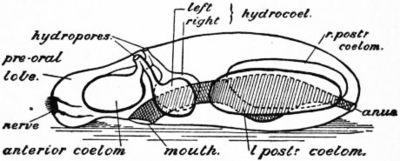Dipleurula is a hypothetical larva of the Echinoderms. It represents the type of basis of all larva forms of the Eleutherozoa, to which the sea-stars, sea-hedgehog, sea-rollers and sand stars belong. The Dipleurula is a bilaterally symmetrical, ciliated echinoderm larva.
Dipleurula represents an ancestral form for these primitive deuterostomes.
We can see that all well-known forms of larvae of Echinodermata are derived from the hypothetical dipleurula. Among them fall the Bipinnaria and the Brachiolaria of the sea-stars, the Auricularia of the sea-rollers and the Plutei of the sea-hedgehogs, and the sand stars. Also the Doliolaria of the Pelmatozoa (sea-lilies and feather stars) can be attributed to the same basic pattern, even if they do not have a mouth opening.
References
External links
- Information on forn
- "Dipleurula". de:Lexikon der Biologie (in German). Spektrum Akademischer Verlag. Heidelberg. 1999. Retrieved 2019-12-30.
